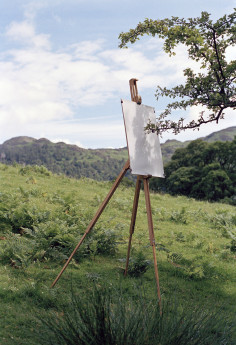TIM KNOWLES
Tree Drawings

source:timknowlescouk
A series of drawings produced using drawing implements attached to the tips of tree branches, the wind’s effects on the tree, recorded on paper. Like signatures each drawing reveals the different qualities and characteristics of each tree.
.
.
.
.
.
.
.
source:inhabitatcom
You may have heard of ‘outside art’ before – but how about letting a tree sketch the next picture to adorn your living room wall? British artist Tim Knowles has created an amazing project to create Tree Drawings — images created by pens attached to tree branch tips!
The old adage that ‘nature does it best’ often applies to art and design undertakings, not to mention images of majestic wilderness and impressive tracts of open landscape. Consider also, mesmerizing examples of the Fibonacci series and the golden mean in both art history and organic architecture as well as biomimicry in contemporary design. But the notion of ‘nature as artist’, or rather as an eco-agent of sorts in automatic drawing, is definitely a new take on environmental interpretation. British artist Tim Knowles has set the stage for plein-air performance art with his poetic and uncomplicated Tree Drawings created by, you guessed it, the branch tips of trees!
Tree Drawings are produced using simple drawing tools attached as freehand extensions to the tips of tree branches. In collaboration with the wind and local weather conditions, calligraphic gestures and automatic drawing readings are recorded on paper. The amazing thing about Knowles’ Tree Drawings is the unmistakable signatures that each drawing reveals as an indication of the unique characteristics and even genus/species of a specific tree.
4 Panel Weeping Willow” (2006), for example, included 50 pens suspended from the branches of a Weeping Willow tree over four panels placed horizontally beneath the tree. The drawing is accompanied by a looped video of its production.
Tree Drawings are pure magic using only the purest art ingredients. Move over abstract expressionists, post-modern arborism is casting a deep, all-knowing shadow on you.
.
.
.
.
.
.
.
source:cabinetmagazineorg
The works presented below are part of a wider practice in which I utilize apparatuses, mechanisms, or systems beyond my control to introduce chance into the production of my art. The pieces here are from a series produced by trees, most of which are located in the Borrowdale and Buttermere areas of England’s Lake District. I attach artists’ sketching pens to their branches and then place sheets of paper in such a way that the trees’ natural motions—as well as their moments of stillness—are recorded. Like signatures, each drawing reveals something about the different qualities and characteristics of the various trees as they sway in the breeze: the relaxed, fluid line of an oak; the delicate, tentative touch of a larch; a hawthorn’s stiff, slightly neurotic scratches. Process is key to my work, so each Tree Drawing is accompanied by a photograph or video documenting the location and manner of its creation.
Tim Knowles is an artist based in London. His work has been included in numerous exhibitions in the UK and abroad, including the Jerwood Drawing Prize and the Hayward Gallery touring exhibition You’ll Never Know. In 2007, he completed a series of new works in collaboration with the Royal Mail. He has been commissioned by the Contemporary Art Society and the Economist to produce a new work for the Economist Plaza in February 2008.
.
.
.
.
.
.
.
source:journaldudesignfr
Tim Knowles est un artiste pluridisciplinaire britannique. Même s’il se défend d’être obsédé par le vent, cet élément a beaucoup inspiré son travail, il aime ses propriétés et son absence de contrôle.
Tree Drawing est un très bel exemple du travail de Tim Knowles, il accroche des feutres aux branches d’un arbre et attend que le dessin se fasse sous l’impulsion du vent ou de la brise sur les branches. Ce qui est beau dans cette oeuvre c’est qu’on peut ressentir les propriétés intrinsèques de l’arbre, qui peut être souple, rigide, léger, fragile.

